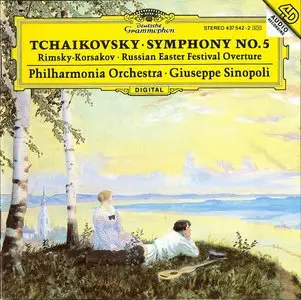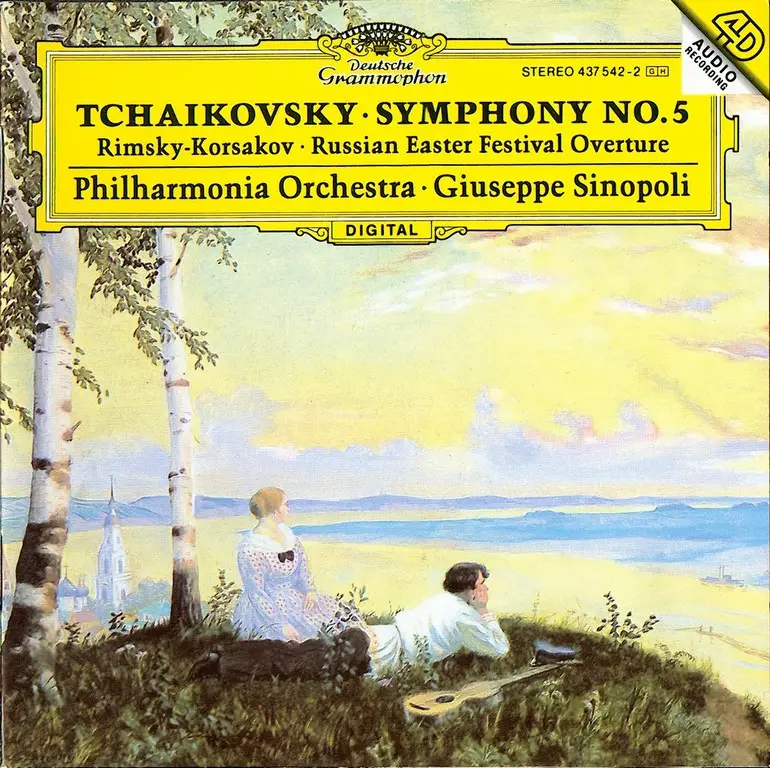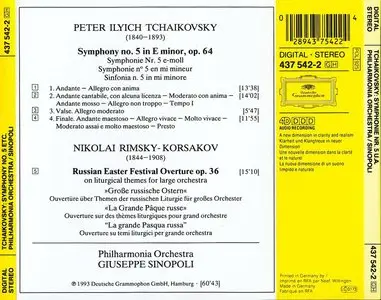Tchaikovsky · Symphony No. 5 · Rimsky-Korsakov · Russian Easter Festival Overture
APE+CUE 269 MB | MP3 HQ (Tracks) 103 MB | EASY CD-DA 12 | No Log | RAR rec. | Covers | Booklet | 1993
Tchaikovsky Symphony No. 5 in E minor, Op. 64.
Rimsky-Korsakov Russian Easter Festival Overture, Op. 36. Philharmonia Orchestra / Giuseppe Sinopoli.
DG F 450 437 542-5GH; CD 437 542-2GH (61 minutes: DDD).
Symphony—selected comparisons:
Oslo PO, Jansons (3/85) (CHAN) CHAN8351 Philh, Muti (9/91) (EMI) CZS7 67314-2
Overture—selected comparison:
Gothenburg SO, Jarvi (3/91) (DG) 429 984-2GH
It is, perhaps, unfortunate that booklet-note writers do not have the opportunity to hear the particular recording of the work that their commentaries are to accompany. When it comes to the third movement Waltz from Tchaikovsky's Fifth Symphony, comments such as our writer's "pure ballet music … the motto's intrusion at the end scarcely seems relevant" are not uncommon. But Sinopoli, I fancy, has other ideas for this Waltz: played up intimations of the grotesque appear as early as the stopped horns (from 036"), not to mention the notorious bassoon solo (from 116"). And those spiccato semiquavers in the Trio have a sting in their scurrying. All (and more besides) of which gives this normally "indolently graceful" (Tovey) Waltz something of the quality of a Mahlerian triple-time nightmare, and most of which, I hasten to add, is sanctioned in the score's markings. More than that, it makes sense of the motto's (Destiny's) 'intrusion' at the end, but in any case, is not this Waltz's very opening descending six-note phrase derived from the descending six-note phrases of the motto itself'?
That motto's first appearance in the Symphony's introduction is imaginatively and darkly moulded (Jansons is relatively plain), and the horn's love song in the slow movement and its accompaniment more than usually suggest a moonlit scene. The second subject groups of both movements bring the familiar operatic treatment, very apt in the case of the slow movement, with Sinopoli urging great intensity from his strings. I rather like, too, his lyrical hymning of the motto in the major at the start of the finale, as opposed to 64 Gramophone March 1994 the military manners of some. All the Allegros are swift; for example, faster in the first three movements than Muti with this orchestra (only available as part of a four-disc set), and comparable to Jansons. Precision of ensemble isn't quite in the Muti and Jansons class but, apart from the third horn entering a bar early in the first movement at 7'58", the Philharmonia is on fine form.
There is already a superb Russian Easter Festival Overture in DG's catalogue from Jarvi, who creates more fantasy and sense of expectancy in the slow sections, and whose merrymaking when under way is better propelled and accented. Sinopoli's opening minutes are very sweetly played, but his allegro tuttis are comparatively heavy and noisy; that last impression, no doubt exacerbated by the stone walls of the reverberant recording location (All Saints' Church, Tooting, London). In both works DG's engineers have taken noticeable steps to overcome confusion problems, with close and widely separated woodwind (the oboes and flutes sound some 20 feet apart—DG's 4D reminiscent of Decca's one-time Phase 4) and hints of solos or groups being 'pulled'. Yet the woodwind with the main Allegro theme of the Symphony's finale are masked by accompanimental pounding brass (after fig. D, 310"), and I was momentarily conscious of an inconsistent focus for string basses, for instance their descending phrases in the last bars of the first movement are inaudible. Nevertheless, this high-level, hugely colourful sound is out to impress, and I'm sure that it will.
JS, Gramophone, page 66 . Review . March 1994
Tchaikovsky Symphony No. 5 in E minor, Op. 64.
Rimsky-Korsakov Russian Easter Festival Overture, Op. 36. Philharmonia Orchestra / Giuseppe Sinopoli.
LINKS APE normal | RS 1 | RS 2
LINK MP3 HQ LAME 3.98 -V0 Stereo | RS





